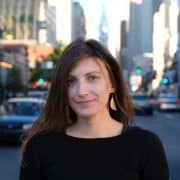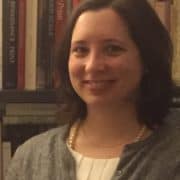Nicole Belolan, Rutgers University-Camden
Nicole Belolan is a social and cultural historian of everyday life and is working on a book and exhibition project about the material culture of physical disability in early America. She lectures regularly about the history of disability for scholarly and public audiences. In addition to pursuing her scholarly interests, Belolan has been working in the Mid-Atlantic region’s museums for over ten years, particularly in the areas of collections management and public programming and interpretation. Currently, she is Public Historian in Residence at the Mid-Atlantic Regional Center for the Humanities at Rutgers University-Camden. She holds a PhD in the History of American Civilization from the University of Delaware.
Paper Overview
What William Birch Left Out: The Visual Culture of Disability in Early America
Like any artist, William Birch (1755-1834) left some people and things out of his depictions of late 18th- and early 19th-century Philadelphia. He included African Americans, working people, dogs, dirt, elite women strolling, and ordinary people gathering. But other sources tell us that the streets of Philadelphia, like other American cities and towns, would have also been populated by people with disabilities. We know, for example, from an April 1806 edition of Philadelphia’s Aurora General Advertiser, a Delawarean sought the return of “a young negro man” named Andrew who “limps a little and stoops very much in his walk.” We also know from a sketch by Lewis Miller (1796-1882) that Jacob Barnitz (1758-1828), a Revolutionary War veteran who served his municipal government in York, Pennsylvania, walked the streets with one leg and canes or walking sticks after doctors finally amputated one of his legs in 1808 due to an old war wound. And we know that children learned about how to treat others from early 19th-century prescriptive literature that depicted people with a variety of disabilities using canes, crutches, and artificial limbs.
Scholars have begun to make sense of representations of people with disabilities in everyday life from after the mid-19th century. Yet we do not know a lot about everyday representations of people with disabilities in earlier American visual culture. To fill this gap, my paper will draw on sources ranging from runaway advertisements in newspapers to illustrations in children’s literature to depictions of people with disabilities by artists such as Lewis Miller and others. Today, we debate the ways we integrate people with disabilities into film, fashion, advertising, and more. Considering what (and whom) Birch left out of his work—people with disabilities—will help us redefine what “liveliness” (to quote Martin P. Snyder’s 1977 essay on Philadelphia prints) might have meant in Birch’s time and what it means in our own.
William L. Coleman, Newark Museum
William L. Coleman is Associate Curator of American Art at the Newark Museum, with primary responsibility for the major holdings of 19th-century paintings. In addition to the 2018 special exhibition there The Rockies and the Alps: Bierstadt, Calame, and the Romance of the Mountains, his projects include a book with the working title “Painting Houses: The Domestic Landscape of the Hudson River School,” on which this paper draws. His work on William Birch and the country house ideal also appeared in his recent article in Huntington Library Quarterly “Painting the Baronial Castle: Thomas Cole at Featherston Park,” which was awarded the 2018 Essay Prize of the Society of Architectural Historians’ Landscape History Chapter. He completed his PhD at Berkeley in 2015 and was an NEH Post-Doctoral Fellow at the Library Company in 2016-17.
Paper Overview
William Birch, Painter-Architect
The Country Seats of the United States of North America poses significant challenges to a 21st- century reader. The commercial failure of William Birch’s second American collection of views seems largely to be the result of his failure to recognize that the fraught class relations of the Early Republic did not make the celebration of aristocratic country life on an English model an especially promising publication model. However, an important aspect of this project has been largely overlooked and helps to explain it not as an insignificant blip in the historic visual culture of the United States but rather as a contribution to a continuing artistic dialogue with broad ramifications on both sides of the Atlantic.
Birch’s reproduction of his own villa, Springland, and views from it in the pages of the Country Seats as a model country place to be emulated urges a reconsideration of this enigmatic artist as a pioneering American painter-architect. This longstanding tradition in western art, which can be traced to Rubens, Raphael, Michelangelo, and beyond, involved the transgression of modern genre boundaries in performance of gentlemanly citizenship of a republic of letters whose members could be expected to have basic skills of both painterly and architectural draughtsmanship. Birch’s approach to the question of how best to shape and inhabit the landscape by manipulating earth and water, nails and wood, in addition to watercolor and oil anticipated and contributed to the rise of diverse manifestations of the painter-architect phenomenon among members of the so-called Hudson River School in the generations that followed.
Daniel Seth Kraus, Tyler School of Art, Temple University
Daniel Seth Kraus’s work blends historical research with photographic practice to
deepen our understanding of people and places. Currently his research investigates the
intersection of faith and work in the American South. He earned a MFA in photography
at the Tyler School of Art at Temple University and also holds a BFA in photography and
BA in history from the University of North Florida. His work has been featured in numerous
print and online publications, including Fraction, SeeSaw, Oxford American, and AintBad. His photographs have been exhibited in national and international juried exhibitions, including the Morris Museum of Art in Augusta, Georgia. Daniel was the 2016 recipient of the College Arts Association Professional Development Fellowship in Visual Arts.
Byron Wolfe, Tyler School of Art, Temple University
Byron Wolfe collaborates on long-term research projects with students and colleagues in fields that range from visual arts to humanities to the natural sciences. He uses photography and other visualization tools to tell stories that reflect upon broader notions of culture, and the constructions of landscape, perception, and time. To date, Wolfe has authored or co-authored six books and his work has appeared in Harpers Magazine, The New York Times, the Los Angeles Times, Orion magazine, and more. He is a Guggenheim Fellow, a co-recipient of the Pollock-Krasner Award for still photography, and a recipient of the Santa Fe Prize for Photography. His work is in numerous permanent collections, including The George Eastman Museum, the San Francisco Museum of Modern Art, and the Museum of Fine Arts in Houston. Wolfe is the Program Director and Graduate Advisor for Photography at the Tyler School of Art, Temple University, in Philadelphia, Pennsylvania.
Paper Overview
Tiny Mysteries: Decoding 19th-Century Microscopic Photographs from Philadelphia’s Langenheim Brothers
Sometime between 1850 and 1858, German immigrant Frederick Langenheim traveled from Philadelphia to New York City and made two photographs. The scenes were preserved in negative on glass plates slightly larger than a U.S. one dollar bill. Frederick and his brother William were Philadelphia entrepreneurs, inventors, and prominent daguerreotypists
(they devised the hyalotype process that produced a positive image on glass that could be enlarged for public viewing with a Magic Lantern Projector). Later, the two photographs were substantially reduced in scale and preserved as pinhead sized images on microscopic glass slides. The source negatives probably no longer exist but the specimen slides survive and are held in the Wagner Free Institute for Science in Philadelphia, Pennsylvania. The images are so small that they cannot be deciphered with either the naked eye or magnifying lens and they require a microscope for viewing.
In 2017, artists Byron Wolfe and Daniel Seth Kraus, collaborated to determine the visual contents of the slides. We determined that one is a maritime view of the docks and shipping vessels from the southern tip of Manhattan looking across the East River towards Brooklyn. The other is from the northern shore of Staten Island looking inland at a plain wooden building that was part of the island’s Quarantine facility for seafaring immigrants. We also set out to answer the many questions that emerged during our investigation of these unusual cultural objects and the corresponding contemporary sites. These tiny forms of material culture are a networked hub of surprising connections between the histories of immigration, science, mental health institutions, information technology, commerce, and of course, the “mechanical art” of photography. In the spirit of William Birch, we propose to present our discoveries and responses, both visual and narrative.
Whitney Martinko, Villanova University
Whitney Martinko is an assistant professor of History at Villanova University, where she teaches classes about the early America, material culture, and urban and environmental history and directs the graduate track in public history. She graduated magna cum laude from Harvard College with an AB in History and earned a MA and PhD in History from the University of Virginia. Martinko has held long-term residential fellowships at the American Antiquarian Society, McNeil Center for Early American Studies at the University of Pennsylvania, and the National Museum of American History as well as research fellowships at Winterthur, the Huntington Library, the Phillips Library at the Peabody-Essex Museum, and a variety of state historical societies. Her writing has appeared in Landscape Architecture Magazine, New England Quarterly, Buildings and Landscapes, Common-Place, and an edited volume, Documenting History, Charting Progress, Exploring the World: Nineteenth-Century Photographs of Architecture. Her first book, The Permanence of the Past: Preservation and Public Property in the Early United States, will be published by the University of Pennsylvania Press.
Paper Overview
James Kidder’s Market: Urban Views and the Art of Commerce
It is hard not to puzzle over the view of Philadelphia’s Market Street that hangs in the Second
Bank of the United States Portrait Gallery. Its massive size and intricate details simultaneously
prompt viewers to step backward and lean in. The image’s maker took the same westward
orientation down Market (High) Street as William Birch did when he depicted George
Washington’s funeral procession. But instead of standing under the market shambles, this painter
elevated his perspective to the roofline, giving viewers a vantage of the market headhouse and
the stalls that extended from it.
This paper draws on archival research to attribute this view to New England imagemaker James
Kidder (1793-1837?), who painted it in 1816 and partnered with Daniel Bowen to tour the image
from Boston to Philadelphia with their Phoenix Museum, which included several works of art.
This paper situates a close visual analysis of the painting in this new object biography to examine political optics, urban views, and the business – and failure – of artistic collaborations in the early American republic. It argues that Kidder deployed the political implications of perspectival conventions to make the case for the instructive value—and market worth—of his broader oeuvre. With a panoramic painting that simultaneously removed and immersed spectators in the market, Kidder sought to affirm and cultivate a moral eye: one that demanded viewers to exercise dual modes of looking that would prompt exclusive economic discernment and inclusive civic empathy in urban economy and society.
By placing Kidder’s painting in conversation with his larger body of urban views, this paper
offers a new view of one work-a-day imagemaker’s strategies for profit in the early republican
marketplace of images. By linking this context of visual production to a rare survival of a so-called “panorama,” it also reappraises the perceived promise and failure of early American
landscape panoramas
Erin Pauwels, Tyler School of Art, Temple University
Erin Pauwels is an Assistant Professor of Art History at Temple University, and a scholar of American art and visual culture. Her research examines the intersections between theater and the visual arts, as well as photography’s changing role and function within the media ecology of the 19th-century United States. She is currently completing a book that will offer the first critical examination of the American artist Napoleon Sarony, a major figure in 19th-century photography whose dramatic approach to portraiture was foundational to the medium’s early reception as a form of fine art.
Paper Overview
Taking a Page from Tuckerman’s Book of the Artists: 19th-Century Print Media and the Grangerization of American Art History
In 1867 when Henry Theodore Tuckerman published his Book of the Artists: American Artist Life, it was only the second history of art in the United States ever to be written. Motivated by pride in the growing prominence of American painters on the world stage, and a desire to cultivate an appreciative audience for their work at home, Tuckerman aspired to chronicle the past, present, and future of American art in such a way that the public would feel personally and patriotically invested in its continuing development.
His goal was supported by the Book of the Artists’ unusually interactive mode of illustration. Unlike standard publications that contained one authoritative set of pictures already bound into the text, Tuckerman’s book was marketed with its illustrations sold separately. They could either be purchased as a set or à la carte to be added in at the discretion of the book’s owner. Options included engraved reproductions of work by the featured artists, and photographic portraits created specifically for the book by New York-based photographers Napoleon Sarony and George Gardner Rockwood. The idea was to promote active engagement with American visual culture by making The Book of the Artists a subject for easy “grangerization.” This popular 18th- and 19th-century practice, also known as extra-illustration, involved supplementing a published text with independently sourced images and ephemera such as prints, correspondence, playbills, and original works of art. By customizing a text to reflect their own sense of a subject’s significance, so-called “grangerites” showcased their taste and talent as collectors while asserting themselves as secondary authors of their own richly illustrated visions of history. In the case of Tuckerman’s Book of the Artists, the practice also enabled readers to represent the enduring importance of print culture to art production, circulation, and appreciation in the United States by documenting a significant moment in its ongoing evolution. Since technology did not yet allow for the direct reproduction of photographs, Sarony and Rockwood’s albumen print portraits necessarily appeared as “originals” within the text, illuminating this account of American artistic accomplishment by allowing two supporting characters and their new medium to be inserted subtly into the pages of art history.
Julia A. Sienkewicz, Roanoke College
Julia A. Sienkewicz is Assistant Professor of Art History at Roanoke College in Salem, VA. She is the author of the forthcoming volume Epic Landscapes: Benjamin Henry Latrobe and the Art of Watercolor. This research has been supported by the Yale Center for British Art, the Winterthur Museum and Country Estates, the Joshua C. Taylor Postdoc at the Smithsonian American Art Museum, and the ACLS/Luce Foundation. Her other published and forthcoming work includes articles in Winterthur Portfolio, Art Inquiries, and The British Art Journal. She holds a PhD from the University of Illinois and a BA from Mount Holyoke College. She is a current Board Member of the College Art Association.
Paper Overview
Rendering the American Landscape: William Birch, Benjamin Henry Latrobe, and the British Watercolor Diaspora
In 1794 and 1795, respectively, William Birch and Benjamin Henry Latrobe both emigrated from London to the United States. By 1799, they would again inhabit the same city—though now Philadelphia, the cultural capital of the young United States. Though contemporaries, with other points of biographical commonality, these two significant figures have not received significant comparative study as artists. The association of the two men is evident in Birch’s plates rendering views of Latrobe’s significant contributions to the built environment of Philadelphia. Yet, perhaps because of Latrobe’s architectural profession, little more has been done to understand their common interest in rendering the young United States through the art of the landscape watercolorist.
Although Latrobe’s production of watercolors tapered off once he moved to Philadelphia, a large
body of images from his preceding years in Virginia offers numerous comparative examples to Birch’s oeuvre. In this talk, I will look at the British watercolor tradition as imported and adapted by these two highly-skilled renderers. The late eighteenth century has been regarded as the “age of watercolor” in Britain and was a period in which the medium opened many possibilities for characterizing the national landscape. Likewise, the comparison of Birch and Latrobe introduces an early moment in the American landscape tradition—preceding the Hudson River School by several decades—in which the landscape watercolor and the estate view helped to characterize the physical landscape of the young country, with the Mid-Atlantic as its focus. For these British immigrant artists, adept watercolor technique offered the opportunity to typify a sense of place and to visualize a sense of belonging (or, alternatively, immigrant displacement) within the landscape. Through realistic and/or idealized renderings, these artists contributed vitally to the process of envisioning the American landscape.
Rebecca Szantyr, Brown University
Rebecca received her MA in art history from Case Western Reserve University and is currently pursuing her doctoral studies in art history at Brown University, where her research focuses on the transatlantic print culture of the eighteenth and nineteenth centuries. For the 2015-2018 academic years, Rebecca held the Florence B. Selden Fellowship in the Department of Prints and Drawings at Yale University Art Gallery. In this post, her projects have included the School of Fontainebleau, Rembrandt, Whistler, Jacob Lawrence, and early lithography. In 2014-2015, Rebecca was the Samuel H. Kress Interpretive Fellow at the Frick Collection, where she specialized in teaching with 18th- and early 19th-century British painting. She has previously held positions in curatorial departments at the Rhode Island School of Design Museum, Yale Center for British Art, and Cleveland Museum of Art. Rebecca’s paper today stems from her dissertation research on the expatriate artist Nicolino Calyo and the idea of American art in the mid-nineteenth century.
Paper Overview
Nicolino Calyo’s Wider View: Landscapes of Innovation
This paper examines the development of the urban-adjacent landscape view in the artwork of Nicolino Calyo (1799-1884) during the middle decades of the 19th century. Like William Birch, Calyo emigrated from Europe, arriving in Philadelphia only a year after Birch’s death, and he would work only briefly in the city before relocating and permanently settling in New York. Despite this “outsider” status, Calyo adroitly forged a career producing landscapes in a variety of visual modes to meet the demands of American audiences. This paper takes as its subject two subsets of Calyo’s painted landscapes: gouache views on paper of Philadelphia and New York and large-scale moving panoramas. I argue that these two approaches to the genre of landscape painting, and moreover, its consumption, complement each other more than they differ. They both aid an increasingly urbanized country to contend with the alteration of its natural resources.
Despite the growing taste and public for American art and subjects in his own era, Calyo’s artistic production has been set outside the traditional narrative, historiography, and media ascribed to the study of American landscape imagery of the nineteenth century, i.e. the rise of large (oil) easel paintings and the explosion of fine art and commercial prints. My research aims to re-inscribe the singular gouache view and “popular,” experiential nature of panoramas into the larger understanding of the imagined, lived, and changing American landscape.
Laura Turner Igoe, Barnes Foundation
Laura Turner Igoe specializes in American art and material culture of the long 19th century and its engagement with environmental conditions and change. She received her PhD in art history from Temple University and her research has been supported by the National Endowment for the Humanities, the American Council of Learned Societies, the Henry Luce Foundation, and the Smithsonian American Art Museum among other institutions. She is the coeditor of A Greene Country Towne: Philadelphia’s Ecology in the Cultural Imagination and she has contributed essays to the journals American Art, Panorama, Common-place, and the forthcoming Princeton University Art Museum exhibition catalogue Nature’s Nation: American Art and Environment. She is currently the Collections Assessment Project Manager at the Barnes Foundation.
Paper Overview
Distorting Views of Philadelphia: Shifting Perspectives in “A Curious Horizontorium”
In an 1833 issue of the National Gazette and Literary Register, the Philadelphia publisher
R. H. Hobson advertised a recently published lithograph of “a curious Horizontorium,
illustrating by a simple expedient what may be called the art of converting horizontal into
perpendicular perspective.” This “curious Horizontorium” referred to an oblique
anamorphosis of the Philadelphia Bank by John Jesse Barker after an original drawing by
William Mason. The optical illusion required viewers to approach the image from a specific
angle along its edge and peer through a pinhole in order for the scene to snap into its correct
perspective. While the Horizontorium initially presents the Philadelphia Bank, one of the
earliest Gothic structures built in the United States, as a soaring, church-like edifice, closer
examination ultimately reveals it as an awkward, squat building, as depicted in the only other
extant image of the short-lived structure, a stipple engraving and etching by William Russell
Birch published approximately two decades earlier.
This paper argues that, through its optical transformation, the Horizontorium did not
merely offer visual entertainment, but also marked a new approach to representing views of the
city and its institutions in the wake of Birch’s popular The City of Philadelphia. The nation’s
fledgling banks occupied an unstable position in the 1830s as newly re-elected Andrew Jackson
sought to demolish the National Bank, which he criticized as fundamentally corrupt. Issues of
transparency and discernment frequently accompanied the reception of bank buildings
themselves. Through its visual manipulation, the Horizontorium participated in these heated
economic and political debates as it encouraged viewers to direct a critical eye upon banking
structures and the urban landscape.
Final Remarks
Elizabeth Milroy, Antoinette Westphal College of Media Arts & Design at Drexel University
Elizabeth Milroy is the author of The Grid and the River: Philadelphia’s Green Spaces, 1682-1876 (Penn State University Press, 2016), winner of the 2017 John Brinckerhoff Jackson Book Prize for significant contribution to the study and understanding of landscape studies. Currently Professor of Art & Art History at Drexel University, she was previously the Zoë and Dean Pappas Curator of Education, Public Programs at the Philadelphia Museum of Art. From 1988 to 2013 she was a professor of Art History and American Studies at Wesleyan University. She has published and lectured widely on such artists as Thomas Eakins, Frederick Law Olmsted and Emma Stebbins, as well as on the history of cultural institutions and public parks. Dr. Milroy received a BA from Queen’s University (Canada), an MA from Williams College and a PhD in the History of Art from the University of Pennsylvania.











